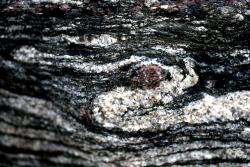Weathering Processes
We met metamorphism back in Module 4. If you take some Earth material (mud, for example) from one environment where it is “happy” (near the surface of the Earth), and move it into a very different environment, the mud changes. Moving the mud deep into the Earth, where temperature and pressure are high, causes new minerals to grow, and the soft mud with its tiny clay particles can become a hard metamorphic rock with big, beautiful crystals of fascinating minerals.
The materials in the mud are stable (or at least nearly so) under conditions found at the surface but not stable under conditions found deep in the Earth. And, perhaps not surprisingly, minerals produced deep in the Earth usually are not stable under surface conditions. Compared to deep in the Earth, the surface is wetter, has more oxygen, has a wider range of acid/alkaline conditions (with acid especially common at the surface), and has many more living things trying to break down the minerals to extract chemicals that are useful to them (“fertilizer”).
As a general rule, the more you change the conditions around a mineral, the faster the mineral changes into something new. (This “rule” has many exceptions, but it is often useful.) At or near the Earth’s surface, the changes that occur to a mineral at a place are called weathering. Moving the products of weathering is called transport. And weathering plus transport are lumped together as erosion.
Weathering, in turn, is divided into mechanical weathering and chemical weathering. Mechanical weathering refers to nature breaking big pieces to make little pieces; chemical weathering refers to nature making new types of materials that were not there previously.
